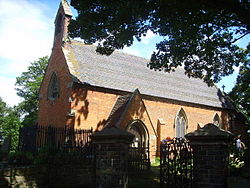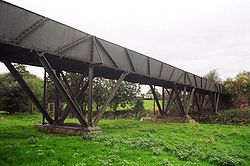Longdon-on-Tern
| Longdon-on-Tern | |
| Shropshire | |
|---|---|
 St Bartholomew's Church | |
| Location | |
| Grid reference: | SJ615154 |
| Location: | 52°44’6"N, 2°34’12"W |
| Data | |
| Post town: | Telford |
| Postcode: | TF6 |
| Dialling code: | 01952 |
| Local Government | |
| Council: | Telford and Wrekin |
| Parliamentary constituency: |
The Wrekin |
Longdon-Upon-Tern (also known as Longdon-on-Tern or colloquially Longdon) is a village and ancient parish in east central Shropshire. It is approximately seven miles east of Shrewsbury and the same distance north-west of Telford. Longdon-Upon-Tern is situated on the River Tern, a tributary of the River Severn.
Settled since at least the Normans, the village is notable as the site of the first large-scale cast-iron navigable aqueduct, designed and built by Thomas Telford for the canal. The aqueduct is Grade-I listed and a preserved as a scheduled ancient monument.
History
The name Longdon is derived from two Old English words, lang and dūn, meaning long hill.[1]
A settlement at Longdon-Upon-Tern dates to at least the Normans, as it is mentioned in the Domesday Book of 1086 as Languedune, held by St Alkmund's Church. It continued with the church until the 12th century when it passed to Lilleshall Abbey until its dissolution in the 16th century.[2] Its Domesday assets were: 2 hides, 5 ploughs, and a mill worth 5s.[3]
Parish
In 1988 the civil parish merged with that of Rodington, however they remain distinct ecclesiastical parishes.[4] The civil parish boundaries now include the areas of Long Waste, Long Lane, Isombridge, Marsh Green, Sugdon, Rodington, Rodington Heath, and Longdon-Upon-Tern.
Church
Today's church is the Church of St Bartholomew. This is a small 18th-century, Grade-II listed, Georgian stone and red brick church. Built in 1742 the church has had major alterations and an extension in the late 19th century.[5] On the same site stands the refurbished Grade-II*-listed Longdon-Upon-Tern village hall,[6] formerly a schoolhouse provided by the Duke of Sutherland and opened in 1849. Due to a decline in population, the school closed in 1970.[4]
Population
There have been no population figures for Longdon-Upon-Tern since 1961 as the census data from Longdon-Upon-Tern is now included with the Rodington Civil Parish. In 2001 the population for Rodington Civil Parish was 869.[7] The last population figure for Longdon-Upon-Tern in 1961 was 126.[8] In 1801 at the time of the first UK census, the population of Longdon-Upon-Tern was 102 and peaked in 1881 at 131.[8]
Aqueduct

The village is particularly notable as the location of the world's first large-scale cast-iron navigable aqueduct (52°44’13"N, 2°34’4"W). Designed by Thomas Telford, the aqueduct opened in 1797 as part of the Shrewsbury Canal.[9] Telford built the 187-ft[9] cast-iron aqueduct to replace a stone aqueduct, originally built by Josiah Clowes, which was swept away by floods in 1795.[9] Although the canal was abandoned in 1944 due to the shift in traffic to the rail networks,[9] the aqueduct remains. It is Grade-I listed and a scheduled ancient monument, situated in fields astride the River Tern. The monument is signposted and visible from the road. Clearly marked footpaths lead directly to the monument from a small roadside car park. Telford later designed and built the very much larger Pontcysyllte Aqueduct in Denbighshire, now designated as a World Heritage Site.
Transport
The closest railway station is four miles away in Wellington, from here there are frequent services to Shrewsbury and Birmingham.[10]
Buses from Wellington to High Ercall pass through Longdon-Upon-Tern with busses departing every 60 minutes from Wellington.[11]
References
- ↑ [1]
- ↑ "Longdon-Upon-Tern"
- ↑ Domesday Book: Languedune, National Archives, UK
- ↑ 4.0 4.1 "Parish Plan", Rodington Parish Church
- ↑ [2]
- ↑ [3]
- ↑ "Neighborhood Statistics", United Kingdom
- ↑ 8.0 8.1 "Population, Longdon-Upon-Tern", Vision of Britain
- ↑ 9.0 9.1 9.2 9.3 http://www.transportheritage.com/find-heritage-locations.html?sobi2Task=sobi2Details&sobi2Id=790
- ↑ http://ojp.nationalrail.co.uk/service/ldbboard/dep/WLN
- ↑ http://www.nationalrail.co.uk/stations/wln/localarea.html
Outside links
| ("Wikimedia Commons" has material about Longdon-on-Tern) |
- National Heritage List 1037006: Aqueduct – Grade I
